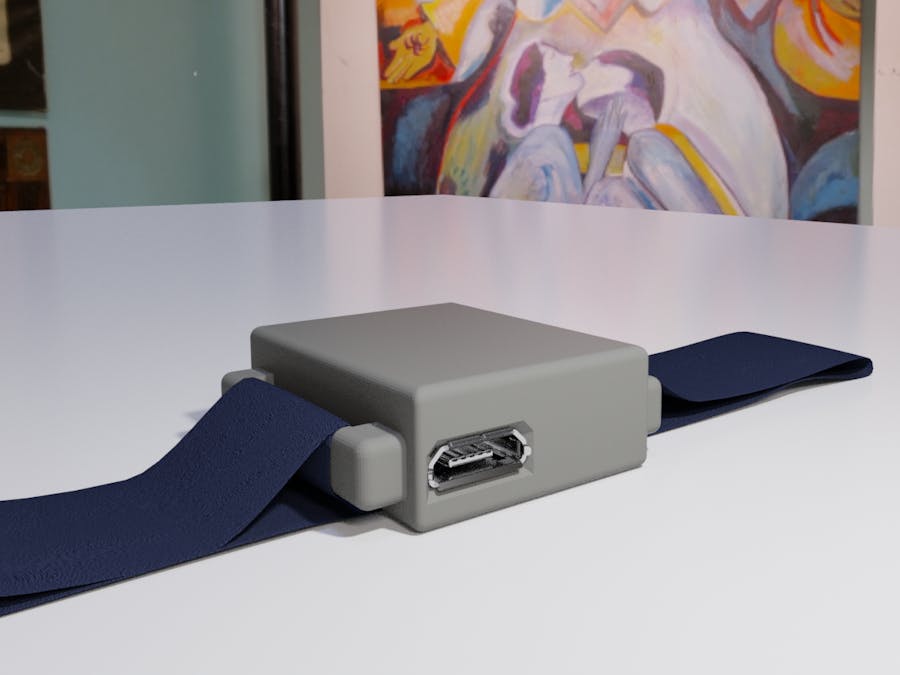Wristband to alert the hands contact with eyes, mouth and nose. The wristband is similar in size to a conventional watch. This device monitors the position of the user's hands and vibrates when they get close to its eyes, mouth and nose. Other functions included are for controlling the chewing time and monitoring the sleep activity. In all functions, the wristband uses an artificial neural network to detect hand gestures. The wristband is open source and all source code can be obtained from the project repository.
Function 1: Avoid Hand-to-Face Contact. The motivation for the development of this function is due to the habit that we are constantly touching our faces with our hands. This can bring all sorts of harmful agents into our bodies. A 2015 study showed that we touch our faces at least 23 times per hour. Health professionals and institutions, including the World Health Organization (WHO), say this "touch habit" is dangerous. Thus, a device that alerts to a hand-to-face movement can help people to reduce this habit that is harmful to health.
It is important to mention for users of this wristband that:
- This device does not replace masks or hand hygiene with soap and water.
- The device may have false negatives or false positives.
- Social distancing is still the best way to avoid COVID-19.
Function 2: Control the Chewing Time. Chewing food correctly and more slowly favors not only for weight reduction, but also aspects such as digestion, absorption of nutrients, lower risk of triggering allergies, health of teeth and intestinal microbiota. Experts say that the nervous system takes about 20 minutes to understand that the stomach is full. Thus, one way to be able to eat less is to take longer time chewing the food. This is the purpose of this second function: to help control the chewing time.
Function 3: Monitoring Activity During Sleep. This function monitors your body movements while you are sleeping. The data presented by the wristband is just a quantity of how much you move while you sleep. Changing position several times indicates restless sleep. If the person moves a lot, they are probably not getting a restful sleep.
Motion DetectionThe wristband uses an accelerometer to identify its slope. See the following video.
Since it is attached to the user's wrist, the degree of tilt on the 3 axes (X, Y and Z) can be used to indicate whether the user's hand is close to their face or not. If a sequence of angles detected by the wristband matches a hand-to-face movement, it will vibrate. Therefore, the mere fact that it is close to the user's face does not trigger the vibrating motor.
The figure above shows the recurrent neural network used to predict the user's hand movements. This network is fed with the data from x, y and z axes of the accelerometer and the output of the network at the previous time. After the training, the network is able to predict a hand-to-face movement with a hit rate of approximately 90%.
It is important to emphasize that at certain times the device may present false positives, i.e., when the wristband vibrates in non-touch movements, or false negatives, when it does not vibrate in touch movements. User can adjust sensitivity to decrease the amount of false positives or false negatives. To adjust this sensitivity, use the Java program (shown in the figure below) included in this project to configure this and others settings of this wristband.
Smart Wristband
Copyright (C) 2020 Davi Carnaúba
This program is free software: you can redistribute it and/or modify it under the terms of the GNU Affero General Public License as published by the Free Software Foundation, either version 3 of the License, or (at your option) any later version.
This program is distributed in the hope that it will be useful, but WITHOUT ANY WARRANTY; without even the implied warranty of MERCHANTABILITY or FITNESS FOR A PARTICULAR PURPOSE. See the GNU Affero General Public License for more details.
You should have received a copy of the GNU Affero General Public License along with this program. If not, see https://www.gnu.org/licenses/.
Source CodeCheck out the source code and other information at https://pulseira.devtag.com.br/home_en













Comments
Please log in or sign up to comment.